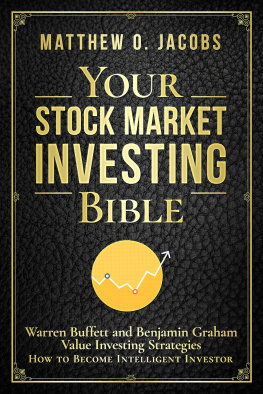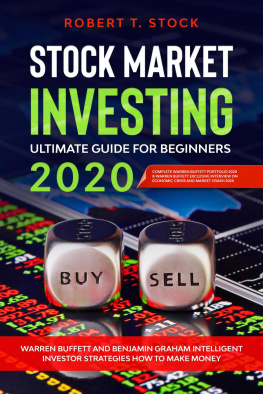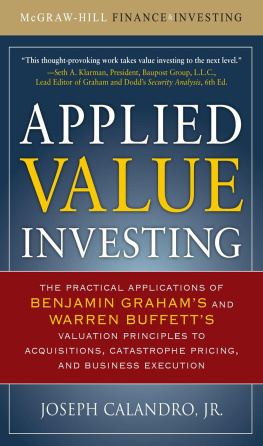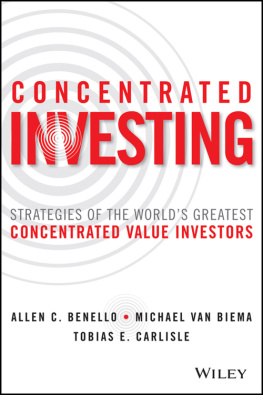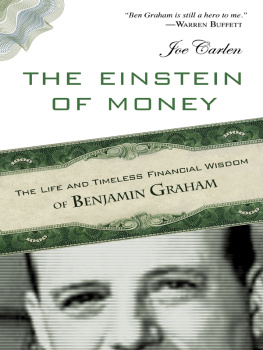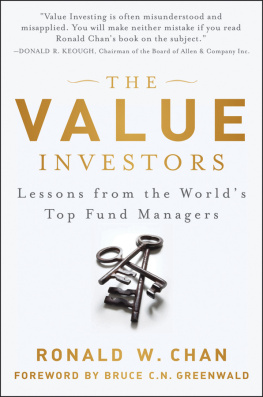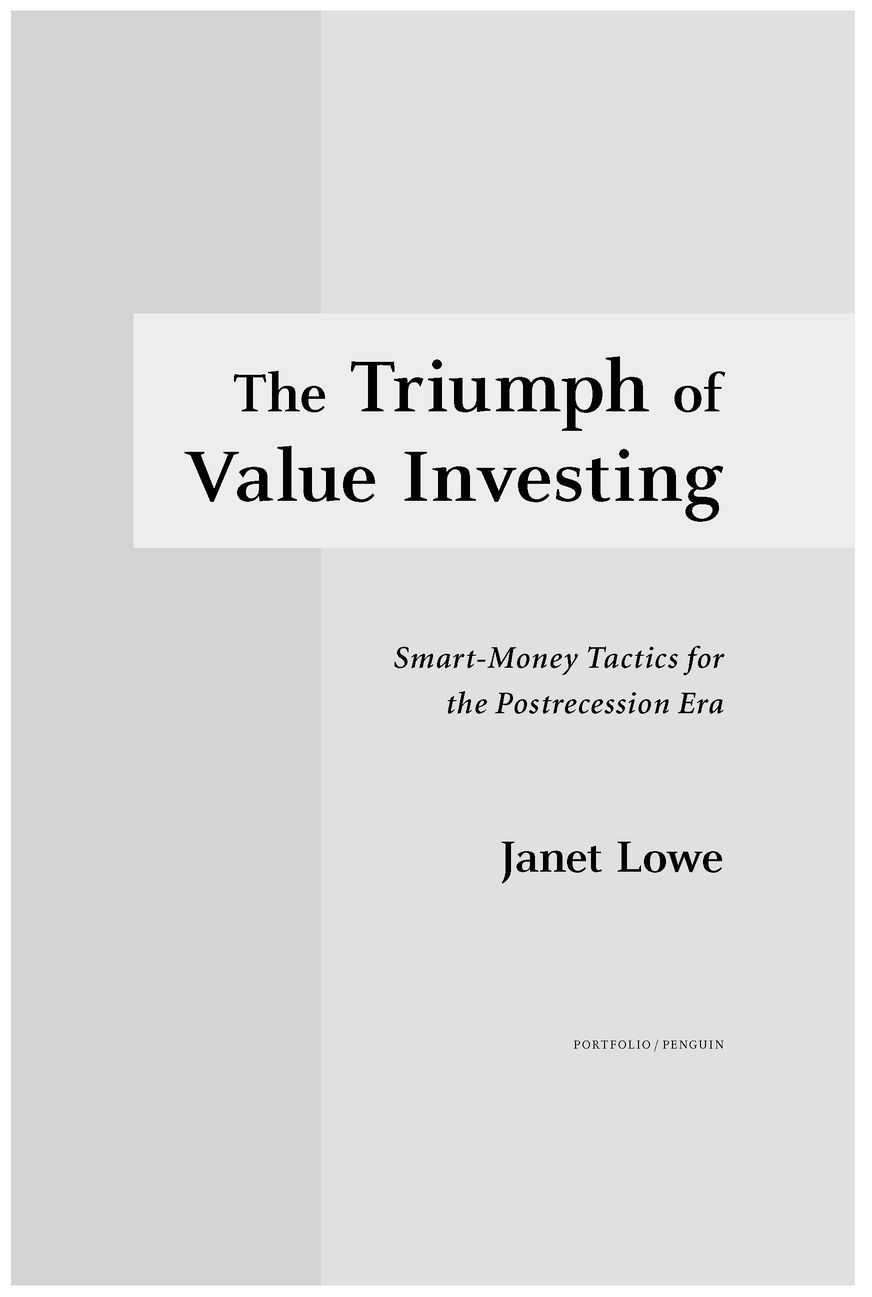Table of Contents
Dedicated to Alan and my entire family, for their patience and loyalty.
Introduction
The past decade has been a trying but an instructive one for investors: first the dot-com bubble burst between 2000 and 2002, then all the worlds stock markets crashed in 2007-8. Almost all investors, regardless of their philosophies, were bloodied. Even many value investors, the most conservative and stable of the bunch, felt the force of the hurricane.
Until they realized how quickly their holdings were rebounding, value investors may have questioned whether their principles still applied.
During the bull markets of the early twenty-first century, Warren Buffetts Berkshire Hathaway Inc., a holding company operated on value principles, was not the most stellar performer on the stock market and was the darling only of Berkshires loyal shareholders. More than thirty thousand enthusiastic followers show up at Berkshires annual meeting each year to cheer Buffett on. They ended up on the victorious team. In 2009 Buffetts company turned in one of the best performances in its amazing forty-five-year history. The companys net worth increased by $21.8 billion and the per-share book value of its stock rose by 19.8 percent.
Another value investor, Seth Klarman, has outperformed the market consistently over a long period, without using leverage or short selling. During the past twenty-five years, his company The Baupost Group has generated an annual compound return of 20 percent and is ranked forty-ninth in Alphas hedge fund rankings. In the pages ahead you will read about these and many more value investors who have either preserved principal or triumphed in very difficult market conditions.
It is always healthy to check up on the validity of your own thinking. Considering the market breakdowns of the past decade, the discouragement many individual investors have suffered, and new federal laws, this is an excellent time to restudy Benjamin Grahams concepts of value investing and learn how to apply them to a whole range of new challenges.
It is time to look at how the principles work and how they can be changed or improved for a world that is technology oriented, virtually borderless, and moving at the speed of electrons.
I first wrote about Professor Graham as a newspaper investment columnist in the 1980s. My original book on the subject, Benjamin Graham on Value Investing (Dearborn), was published in 1994 and my second, Value Investing Made Easy (McGraw-Hill), came out in 1996. This began a deepening interest in value ideals and those who practice this form of investing. While value investing has been called a formula by some, I didnt see it that way. Graham himself was curious, experimental, and always looking for new and better ways to apply basic principles.
The Triumph of Value Investing: Smart-Money Tactics for the Postrecession Era returns to that familiar ground. The book will walk investors through the steps necessary to determine intrinsic value, identify a margin of safety, and apply the other guidelines that define value investing. It celebrates the sound principles and deep truths underlying Grahams concepts.
Whether a reader is familiar with value investing or is just discovering what superinvestor Warren Buffett calls the village of Graham and Doddsville, there will be plenty of fresh information in The Triumph of Value Investing. The book covers the latest concepts and players in the market. It takes into consideration ideas, industry developments, experiences, and company stories that have occurred in the past decade or so. It addresses the issue of investing in high technology, biotech, and foreign companies, and explains the use of products such as index funds and exchange traded funds (ETFs). Additionally, the book guides the investor to Internet resources to gather information for analysis, support decisions, make purchases, and manage portfolios. Most of all, the book recognizes that financial advisers of various types and government regulators may never be able to adequately protect our money. While advisers and governments are important and should be accountable, we also must learn to take care of ourselves as much as we can. The best defense is knowledge.
This book is written for individual investors, whether those investors want to manage their own money or simply to better understand how their money is being handled.
Please refer to the glossary at the back of the book for more detail if there are terms you dont understand. Even when a subject is discussed within a chapter, reading the definition of the terms involved may lead to a deeper understanding. The reading list and compendium of useful Internet sites will lead to information that will deepen your understanding of the investment world and help you to develop the type of intuition that Warren Buffett and others have found indispensable.
The Triumph of Value Investing includes interviews with current, leading value investors such as Warren Buffett, William ONeil, David Iben, Charles Brandes, Alan Bradford, and others. I would like to thank these people for the time they spent talking to me and for their passion for investing. Also, thanks to my literary representative, Alice Martell, my editor, Courtney Young, and Matthew Boezi and Alissa Amell at Portfolio Penguin who made this book possible.
Most of all please enjoy the book. Investing, after all, is one of the most fascinating exercises there is and should be fun.
Janet Lowe
Santa Fe, New Mexico, 2010
Chapter 1
Value Investing in Troubled Times
I could not, at any age, be content to take my place by the fireside, and simply look on. Life was meant to be lived. Curiosity must be kept alive.
ELEANOR ROOSEVELT
People everywhere entered the twenty-first century feeling more optimistic, wiser, richer, and more in control than at any other time in recent history. This was especially true for Americans. For seventy years the U.S. economy had grown at a steady pace, generating ever-higher incomes, standards of living, and wealth levels. Despite the way we started, however, it has been a rocky century for investors so far. The signs of turmoil came quickly in the new millennium.
Powered by the indiscriminate creation of Internet companies and excessive exuberance in high technology in general, the dot-com bubble popped with near-devastating effects in 2000 and 2001. So-called prefix investing was rampant as newly formed companies were seeing their stock prices shoot up by simply adding an e- prefix to their name or a .com at the end.
Some big dreams came crashing down after March 10, 2000, when the technology-heavy NASDAQ Composite Index peaked at 5,048.62, more than double its value just a year earlier. The next Monday, multibillion dollars worth of sell orders for major bellwether high-tech stocks such as Cisco, IBM, and Dell hit the exchange. This initiated a chain reaction as investors, funds, and institutions liquidated positions. Within six days the NASDAQ lost nearly 9 percent, falling to 4,580 by March 15. By October 2002 the dot-com correction wiped out $5 trillion in market value for technology stocks, helping to trigger a mild economic recession.
A Second Tsunami Hits Wall Street
Most investors did not seem to hear the warning shot; within a very few years the Web 2.0 movement sparked a fresh round of venture capital and initial public offering (IPO) investing and speculation.



